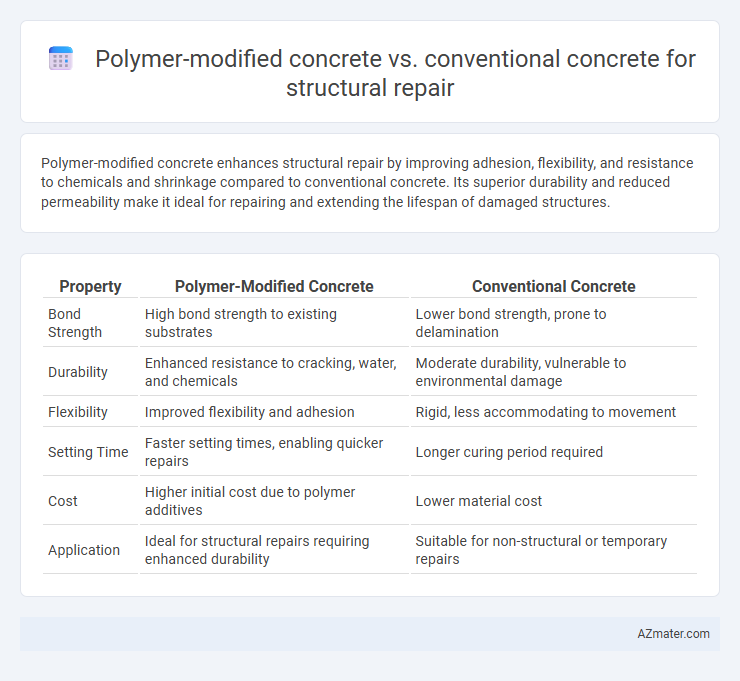Polymer-modified concrete enhances structural repair by improving adhesion, flexibility, and resistance to chemicals and shrinkage compared to conventional concrete. Its superior durability and reduced permeability make it ideal for repairing and extending the lifespan of damaged structures.
Table of Comparison
| Property | Polymer-Modified Concrete | Conventional Concrete |
|---|---|---|
| Bond Strength | High bond strength to existing substrates | Lower bond strength, prone to delamination |
| Durability | Enhanced resistance to cracking, water, and chemicals | Moderate durability, vulnerable to environmental damage |
| Flexibility | Improved flexibility and adhesion | Rigid, less accommodating to movement |
| Setting Time | Faster setting times, enabling quicker repairs | Longer curing period required |
| Cost | Higher initial cost due to polymer additives | Lower material cost |
| Application | Ideal for structural repairs requiring enhanced durability | Suitable for non-structural or temporary repairs |
Introduction to Concrete in Structural Repair
Polymer-modified concrete (PMC) enhances conventional concrete by incorporating polymer binders, which improve adhesion, durability, and resistance to chemicals and moisture. Conventional concrete consists mainly of cement, water, and aggregates, offering good compressive strength but limited flexibility and bonding characteristics in structural repair applications. PMC's superior mechanical properties and reduced permeability make it a preferred choice for repairing deteriorated structures, ensuring longer service life and enhanced structural integrity.
Understanding Conventional Concrete
Conventional concrete consists of cement, water, aggregates, and sometimes admixtures, providing good compressive strength but limited flexibility and susceptibility to cracking under stress. It relies on the chemical hydration of cement to achieve durability but often lacks the toughness and adhesion needed for efficient structural repair applications. Understanding these inherent properties is crucial for evaluating when polymer-modified concrete might enhance repair outcomes through improved bonding, reduced permeability, and increased mechanical performance.
What is Polymer-Modified Concrete?
Polymer-modified concrete (PMC) is a composite material that integrates polymers with traditional concrete to enhance its mechanical properties and durability. It offers superior adhesion, flexibility, and resistance to cracking compared to conventional concrete, making it ideal for structural repair applications. The polymer additives improve bonding with existing substrates and increase resistance to chemical attacks, water infiltration, and freeze-thaw cycles.
Key Material Properties Comparison
Polymer-modified concrete exhibits significantly enhanced tensile strength, adhesion, and flexural strength compared to conventional concrete, making it ideal for structural repair applications requiring durability and crack resistance. Its improved chemical resistance and reduced permeability contribute to superior durability in harsh environments, directly impacting the longevity of repaired structures. Additionally, polymer-modified concrete typically offers faster curing times and better bond strength with existing substrates, facilitating efficient and effective restoration of damaged infrastructure.
Bond Strength to Existing Structures
Polymer-modified concrete exhibits significantly higher bond strength to existing structures compared to conventional concrete due to its enhanced adhesive properties and reduced permeability. The presence of polymers improves the interface compatibility, leading to better stress distribution and crack resistance in structural repairs. Studies show bond strength increases by up to 30-50% when using polymer-modified formulations, ensuring durable and reliable restoration of damaged concrete elements.
Durability and Longevity Performance
Polymer-modified concrete exhibits enhanced durability and longevity for structural repair due to its superior resistance to chemical attack, abrasion, and freeze-thaw cycles compared to conventional concrete. The polymer additives improve adhesion and reduce permeability, significantly mitigating issues such as cracking and spalling over time. Studies indicate polymer-modified concrete can extend service life by up to 50% under harsh environmental conditions, making it a preferred choice for long-term structural rehabilitation.
Resistance to Chemicals and Environmental Factors
Polymer-modified concrete exhibits superior resistance to chemicals and environmental factors compared to conventional concrete, thanks to the incorporation of polymers that enhance its impermeability and bonding properties. This resistance makes it ideal for structural repair in aggressive environments, as it minimizes deterioration caused by acids, alkalis, chlorides, and freeze-thaw cycles. Conventional concrete often suffers from reduced durability under chemical attack and exposure to moisture, leading to faster degradation and higher maintenance needs.
Application Techniques and Workability
Polymer-modified concrete enhances adhesion and flexibility in structural repair through improved bonding agents, enabling application on vertical and overhead surfaces without sagging or slumping. Its superior workability reduces shrinkage and cracking, facilitating easier mixing, placing, and finishing compared to conventional concrete, which often requires more water and compaction efforts. Specialized techniques such as spraying and troweling are more effective with polymer-modified mixtures, ensuring durable repairs in challenging environments.
Cost Implications and Economic Analysis
Polymer-modified concrete (PMC) exhibits higher initial costs than conventional concrete due to expensive polymer additives and specialized mixing processes. However, PMC offers improved durability, reduced maintenance, and extended service life, leading to lower lifecycle costs in structural repair projects. Economic analysis reveals that despite upfront expenses, PMC's enhanced performance delivers cost savings over time, making it a financially viable choice for critical infrastructure rehabilitation.
Case Studies and Real-world Examples
Polymer-modified concrete (PMC) enhances adhesion, durability, and resistance to chemicals compared to conventional concrete, making it ideal for structural repairs exposed to harsh environments. Case studies such as the rehabilitation of the Sydney Harbour Bridge demonstrated significantly improved crack resistance and longevity using PMC over traditional concrete methods. Real-world applications in highway bridge repairs and marine infrastructure show PMC's superior performance in preventing water ingress and deterioration, leading to extended maintenance intervals and cost savings.

Infographic: Polymer-modified concrete vs Conventional concrete for Structural repair
 azmater.com
azmater.com